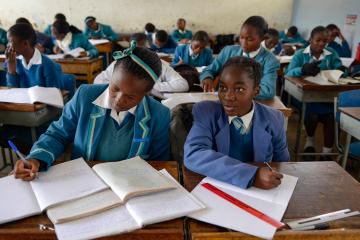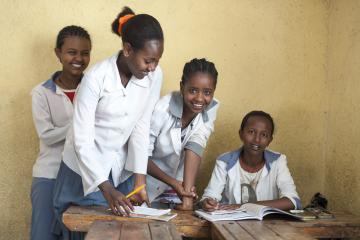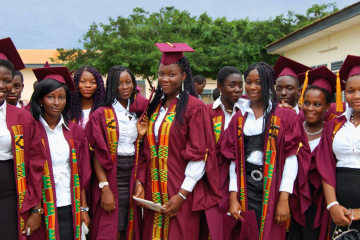
Advancing the Agenda in Girls' Education Research
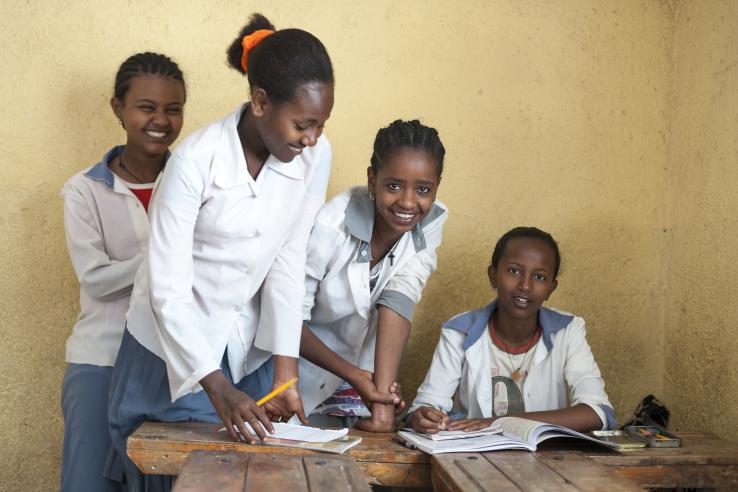
This post was originally published by the Center for Global Development on February 8, 2023.
Girls’ education remains a global priority for donors and many governments. In 2020, 92 percent of the FCDO’s and 77 percent of World Bank education aid money went to projects that included girls’ education. It’s been hailed as a silver bullet by prime ministers and philanthropists, and the G7 claims that “nowhere is our resolve stronger than in addressing the global set-back [post-COVID] in girls’ education.” National governments also highlight the importance of girls’ education: Liberia’s Ellen Johnson Sirleaf wrote that “investing in girls’ education is not only a moral imperative, it is a smart investment.”
This resolve, by both donors and national governments—alongside great advances in knowledge about what works to get girls in school and learning—is starting to pay dividends. Over the past two decades tremendous progress has been made to improve girls’ access to schooling. Data on learning similarly suggests that gender gaps may be narrowing. Yet, in some places, especially at the secondary level and among poor and vulnerable populations, progress remains too slow. And once women leave school, gender inequality remains acute and deeply rooted in the economic, political, and social spheres. Much remains to be done to get girls in school and learning and to better understand how education can most effectively contribute to equal adult life outcomes for men and women.
We suggest that the research community should coalesce around a set of coherent research priorities to help close gender gaps in education. In this note, we—a group of researchers who commonly adopt varying research traditions and approaches—have come together to outline some crucial next steps to advance the research agenda on girls’ education. We propose five areas where researchers can better collaborate to advance the field, and we call for better coordination among researchers—and better collaboration among researchers, policymakers, and funders—to keep advancing our knowledge and action for girls' education and women’s empowerment (Figure 1).
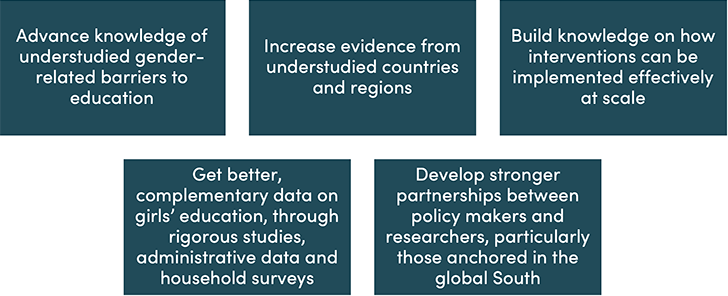
1. Advance knowledge of understudied gender-related barriers to education
The evidence from rigorous quantitative research on how to improve girls’ education has expanded significantly in the last few decades. A number of different approaches have proven consistently effective at improving education outcomes for girls—including addressing inadequate school access, economic barriers (such as tuition and fees, or lack of adequate food), and poor pedagogical approaches. (Some of these interventions target girls specifically; others improve schooling overall.) For example, a 12-year evaluation of a scholarship scheme in Ghana found that adolescent girls who received the scholarship were 26 percentage points more likely to complete senior high school and 4 percentage points more likely to complete tertiary education; many of these students would not have otherwise attended school. The study also found delays in the onset of childbearing.
However, we still don’t know enough about gender-specific barriers to education. Too many girls are out of school, leaving school, or are in school but not learning. What’s going on? In many cases, we just don’t know. A recent systematic review of randomized controlled trials and quasi-experimental studies considered 18 gender-related barriers to girls’ education, from a simple lack of support for girls’ education to a lack of access to schools and a poor pedagogical environment. For eight of those barriers, there was not enough directly relevant research to draw conclusions with confidence about the impact of interventions on education outcomes. In some cases, these are interventions pursued by a great many governments and implementing organizations with the goal of advancing girls’ education, and we simply do not know enough about whether or not they are effective.
Fertile grounds for future research include child marriage and adolescent pregnancy (where just four existing studies were found), eliminating school-related gender-based violence (zero studies), health and childcare services (one study), menstrual health management (four studies), and the impact of sports programs (one study). Too few evaluations assessed whether addressing these barriers can improve education outcomes for girls. Addressing a lack of teaching materials and supplies also fell in this category of insufficient evidence because efforts to do so were all part of multicomponent interventions (and in some cases, a very minor component), and no studies were found that evaluated programs removing gender bias from textbooks or other teaching materials.
Of course, in some cases there are evaluations that assess whether addressing these barriers affects non-education outcomes, such as violence, health, or harmful gender norms. Tested interventions may be effective at achieving those goals, but we don’t know whether they are effective interventions for improving girls’ enrolment, attainment, literacy, or numeracy. Education outcomes aren’t the only reason to address gender-related barriers to schooling. Literacy and numeracy are absolutely key, but there are other reasons—rights, dignity, wellbeing—that matter. Some evaluations of menstrual health supply interventions might not be convincing for education outcomes, but if it is a priority as a matter of dignity, the question becomes which menstrual health management approaches work to achieve that goal. Eliminating some barriers, such as violence, is simply a right, and the research priority will be how schools and education systems can fulfil those rights.
Other approaches to address barriers to girls’ education (such as life skills programs) also need more research on their education impact. This is less because there are too few studies and more because the evidence has been inconsistent across programs. This is unsurprising, since the programs are often very different and the results are affected by whether the design of the program is appropriate to the context and how well the programs are implemented, their specific content, duration, etc. For these barriers, more research on implementation and how and why the programs have different effects is the priority.
Moreover, the nature and extent of barriers to girls’ education could be changing in contexts most severely affected by the effects of climate change, conflict, or health crises. This will require new evidence to understand the challenges and identify how to tackle them.
A common thread underlying all these barriers is harmful gender norms and behaviors. Many studies show that gender norms can moderate the impacts of interventions addressing health, economic, and violence outcomes, among others. We also know that programs that directly address gender and power often have improved outcomes (including economic, sexual and reproductive health, and empowerment), and more evidence on this in education would be valuable. Pressing questions include how to change these norms. For example, how can interventions be designed to shift harmful gender norms in a given context? How does better education for girls shift gender norms? How can schools contribute to dismantling gender norms and behavior that perpetuate inequality, violence, and injustice? Quantitative and qualitative research can help answer these critical questions.
2. Increase evidence from understudied countries and regions
Despite the thematic gaps outlined above, the total amount of evidence on what works to help girls overcome at least some obstacles to their education has increased dramatically in recent years. But when you look closely, you find that much of that evidence comes from a relatively small number of places. Below, you can see maps of coverage from two recent reviews of evaluations to improve or expand girls’ education. While it makes sense that countries like India and China, which have large populations and diverse contexts, have more studies, large swaths of sub-Saharan Africa have little evidence about what works to improve girls’ education, and that needs to change.

Why does this matter? We don’t need the highest quality evaluation evidence about every single program from every single context. Countries and localities can learn from what has worked elsewhere. But to take lessons from a successful program in one setting and apply them in another setting, some conditions need to be in place. For example, two conditions laid out by Bates and Glennerster are that (1) conditions in the new context are similar enough in key ways that we’d expect the same program (or some variation of it) to work, and (2) there is evidence that the program could actually be implemented well in the new context. What this means is that if the places where we have little evidence have very different conditions (e.g., students face different barriers) or very different capacity to implement programs from the places where we have relatively more evidence, then we’re going to be limited in our ability to bring what has worked to a new place. What worked in urban India may not in rural Chad.
There are many geographic gaps in our knowledge about how to improve girls’ education for which urgent research is needed, including the following:
- Low-income countries: we know much more about middle-income countries than low-income countries. While there are many low-income people in middle-income countries, the financial resources to tackle the problem and train civil servants to implement solutions at scale may be very different in low-income countries.
- Fragile and conflict-affected countries, or among refugees in other countries: Lots of challenges are magnified by the uncertainty that both systems and individuals face in fragile settings.
- Certain geographic regions, like the Sahel: No two countries have the exact same institutions and social norms (and indeed, there is often great variation within countries), so when we have scarce evidence from whole areas, we have to be very cautious about bringing evidence from elsewhere. This may be particularly important in areas where girls’ schooling or women’s labor force participation are particularly low.
We aren’t starting from zero in new locations: some solutions, like reducing the cost of admission to school and travel to school, have evidence from a wide-enough array of contexts that the key question is how best to implement them. For overcoming other challenges, as mentioned above, we lack even evidence in stable, middle-income settings, much less the most challenging environments. This needs to change.
3. Build knowledge on how interventions can be effectively implemented at scale
Much of the research on girls’ education draws conclusions from small-scale pilot interventions implemented with a few hundred or a few thousand girls, often by implementing partners such as NGOs. That creates challenges for translating these programs into scalable models that are institutionalized through government systems. Even within smaller evaluations, we sometimes don’t learn as much as we could about how girls are affected and what could scale effectively.
To see girl-focused programs implemented at scale, the research community can support policymakers by:
- Unpacking effects on girls and providing evidence on causal pathways in pilot evaluations to understand how interventions lead to behavior change and improved outcomes;
- Undertaking qualitative research alongside quantitative research to advance knowledge on complex, context-specific barriers to girls' education;
- Integrating learning into the process of scaling to effectively incorporate the lessons from piloted interventions into the program and correct along the way;
- Evaluating programs at scale to monitor the size of effects and the issues that may arise as a larger number of girls are targeted
First, unpacking the effects of all education programs for girls is critical to achieve long-term change at scale. According to a recent report, only one in three studies of education interventions (not specifically targeted at girls) disaggregate impacts by gender—an entirely fixable omission that limits what we know about improving girls’ education. Understanding gender-specific effects of education interventions may help to reveal if girls respond differently than boys to certain interventions. In addition, girl-focused interventions are often multi-component, and impact evaluations don’t always unpack which components are driving effects. For example, life skills programs often provide training for a number of different issues—from reproductive health to vocational training—and are frequently combined with savings, cash transfers, or health services. The impacts of these life skills programs are often measured on aggregate, even though scaled-up programs are often limited to fewer components. Analyzing which program components are driving impact, such as by integrating mechanism experiments into rigorous evaluations, could help us understand why and when girls respond positively to certain interventions.
Second, qualitative approaches to gender research can contribute significantly to advancing knowledge of complex, multi-layered, and contextually rooted phenomena, such as norms and culture, which often contribute to the acute and persistent constraints faced by girls. These approaches have an advantage in bringing marginalized voices and hidden perspectives to center stage and into the policy space. In doing so, qualitative research can be transformative not just for the ways in which reform is imagined and implemented by policymakers, but also for updating the understanding of the nature of the problems themselves. Narratives grounded in empirical qualitative work can be powerful tools for influencing policy change.
Used alongside quantitative research, qualitative gender research brings complementarities. Descriptions of the subjective lived experience of girls (and boys) navigating their home and school life, the choices and negotiations they’re making, reveal processes and mechanisms that can help generate hypotheses and identify overlooked areas for intervention and reform. Qualitative research on gender is particularly suited for answering questions about the how and why, for interventions that work and those that do not.
Third, integrating learning into the scale-up process can also demonstrate whether a program can be implemented with fidelity as it grows over space and time. For example, process evaluations such as those conducted to scale the Teaching at the Right Level literacy program in Zambia can help partners identify and resolve roadblocks at each stage of implementation, setting up systems for more effective delivery over time. Conducting impact evaluations in the early stages of scale delivery may not be necessary and sometimes simply capture implementation failures which can be identified through simpler means.
Fourth, once programs are being delivered at scale through government systems, further impact evaluations and political economy analysis can help to assess the size of the impact and to identify what happens when many people receive the program. These may include spillover benefits to non-participants (e.g., when enough girls are going to secondary school it becomes expected for other girls as well), or it may undermine benefits (e.g., by overcrowded classrooms resulting in poor learning outcomes). This may be particularly important for policies that are less easy to implement and where there are more opportunities for impacts to be lost because of implementation challenges. Good research partnerships exist where research teams work with governments to run experimental or quasi-experimental evaluations of evidence-based, girl-focused programs as they roll out. For example, the Adolescent Girls Initiative-Kenya was piloted as a four-arm randomized controlled trial that allowed researchers and stakeholders to tease apart the program’s impactful elements (including on school retention and learning) and is now working with the Wajir County government to test a leaner version for scale that is implemented by and through the county infrastructure.
4. Get better, complementary data on girls’ education through rigorous studies, administrative data, and household surveys
Policymakers use data to make decisions about education investments from a range of sources. Three useful sources are academic studies and evaluations, household surveys, and administrative data. All have the potential to support good policymaking, especially when used in tandem with each other.
As we described above, evidence on what works to improve girls’ schooling from academic studies is accumulating fast. But, while academic studies on girls’ education are often rigorous, they tend to be small-scale and insulated from political economy challenges. In some cases, studies are run without policymaker engagement and may not answer the questions that are most important for domestic education policy decisions. The cost of policymaking without evidence is high and so researchers should take more care to ensure that their impact evaluations are relevant to policymakers. But rigorous research also needs to be complemented by other sources of data and analysis that allow diagnosis of challenges and can identify changes at scale over time.
Countries need good administrative data that provides them with timely and reliable insights. Most countries have administrative data, e.g., an education management information system (or EMIS), but in many cases they are underexploited or are of low quality, thus not serving to accurately diagnose the current challenges to girls’ education. They often lack the basic data that tells them how much education girls are getting, what quality it is, and whether they are safe at school. The lack of publicly available administrative datasets—and the inability to link those datasets to each other—prevents policymakers and researchers from answering basic questions (for example, was free secondary schooling in Ghana associated with faster enrolment by rural girls, or not?). If those administrative datasets were well cleaned and made public in a timely manner, it may still not be possible to make a causal inference on this question, but it would give policymakers a much clearer sense of whether the outcomes they seek to improve are moving in the right direction.
Beyond administrative data, which is usually collected in schools and funnelled upwards, household surveys provide insights pertaining to the welfare, wellbeing, and outcomes of children. Vitally, since these surveys are conducted in households, they include children who are not enrolled in school, illuminating key education issues like drop-out, poor literacy skills, child marriage, and gender-biased preferences in education investments. Household surveys—like the Demographic and Health Survey and the Multiple-Indicator Cluster Survey—have, for decades, generated data on the wellbeing of children and women. We encourage donors to keep funding these surveys. But we suggest that they could be even more useful for education policymakers if they included more modules directly related to education issues. For example, there is no reliable, cross-country data on violence in schools. A module on school violence in these household surveys would greatly enhance the field’s understanding, willingness, and ability to run interventions to protect girls from violence.
Alongside these three types of data and evidence, policymakers would benefit from tools to diagnose which obstacles are most acutely holding girls back. From the 18 obstacles to girls’ education that researchers have identified, what should a country prioritize? Developing a decision tree—like the one used to identify binding constraints to economic growth—that can help to identify the most pressing constraints and populating it with local data can help researchers and other advisors avoid providing policymakers with an unprioritized laundry list of problems. In addition, stronger administrative data could inform rapid and cost-effective evaluations, allowing governments to test innovations at scale in real-world settings.
5. Develop stronger partnerships within the research community and between policymakers and researchers, particularly those anchored in the Global South
There is an acute and increasingly recognized underrepresentation of rigorous research in low- and lower-middle income countries by scholars based in the Global South in economics and development scholarship. This is well documented. Chelwa found that between 2005 and 2015, only a quarter of journal articles published about Africa had at least one Africa-based author. Briggs and others found that the percentage of Africa-based authors publishing in two Africa-focused political journals has been declining over time.
This challenge extends to education research. A recent study by Mitchell, Rose and Asare analyzing the Africa Education Research Database found a large number of studies by researchers based in Africa that merit greater scholarly engagement. But they also found evidence that many international collaborations were dominated by northern researchers often driven by funder agendas.
While Southern-based researchers are the ones best placed to understand contextual education priorities and demands for research from policymakers, recognition of this has been more talk than walk. (In some sectors even talk lags!) These researchers face persistent barriers of funding and opportunity. While more attention is now being paid to research partnerships with policymakers and scholars based in the Global South, too often these still involve hiring a local field team to collect data which is shipped back to the US or Europe for analysis and then delivered to government policymakers, perhaps with a launch workshop. This often has limited policy impact, because it is not timely, locally owned, or responsive to policymaker needs.
We suggest that the girls’ education research community needs to move toward more partnerships that are anchored in countries and led by scholars in the Global South. These should be strong partnerships with teams undertaking joint research and producing analytical policy products, including engagement with government policymakers and NGOs implementing programs throughout the research process.
One example of such a research-implementation partnership is research currently underway between the University of Dar es Salaam in Tanzania, the University of Cambridge in the UK, and the NGO, Campaign for Girls’ Education (CAMFED) on how education interventions could help to improve gender norms within local communities. This highlights the benefits of collaborating on research for which there is a mutual agenda and with sustained interaction, with the aim of engaging with and informing policy and practice. Similarly, a locally grounded partnership between The Citizens Foundation (an education service provider) and researchers at the Lahore University of Management Sciences and the Institute of Development and Economic Alternatives in Pakistan is designed to generate understanding of pathways that allow women and men to leverage education to negotiate better outcomes for themselves and their families and to understand the mechanisms through which more and better quality education nudges gender norms in a positive direction.
Better coordination among researchers, policymakers, implementers, and funders will help advance knowledge and action for girls’ education
In this note, we highlight five areas that should be a focus for researchers to advance the field of girls’ education. A wealth of evidence finds girls’ education yields a wide range of benefits, for both girls and their families. Despite this, too many girls are still being left behind. We need better data and better strategies to reach those girls. And we need better evidence to change norms and promote the implementation of policies, within and outside of education systems, that will achieve gender equality beyond the school gates.
Researchers working on girls’ education need to collaborate better with each other—and with policymakers, advocates, and funders—to ensure our work is helping advance the field of girls’ education. Of course, the authors of this note are not the only researchers working on gender and education, and our analysis of priorities may not align with those of others. We welcome alternative perspectives on the best ways to move the girls’ education research agenda forward.
While education conferences abound, there are few opportunities for substantive dialogue between researchers and policymakers on these priorities. We suggest a dedicated annual meeting of education researchers, donors, and policymakers to advance the girls’ education research agenda. A meeting like this could help continue to define research priorities, give policymakers a forum to request support from researchers, and give a platform to researchers whose voices are less heard. More collaboration like this will ensure that we continue to make progress on education for girls.



